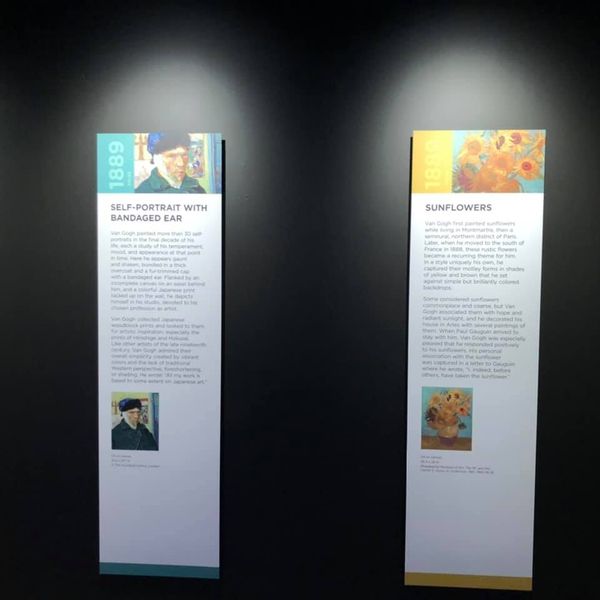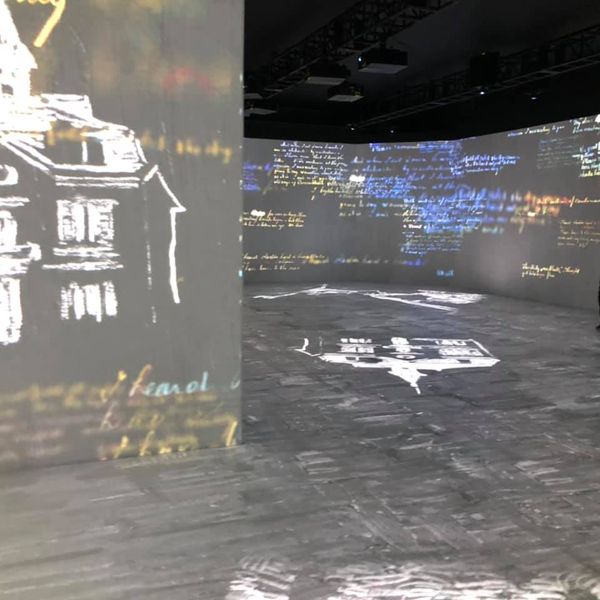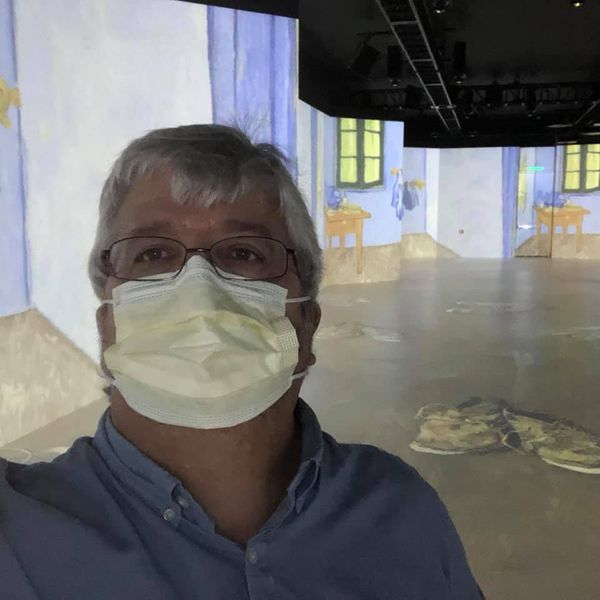Before he took a humiliating exit as director and CEO of Newfields, which houses the Indianapolis Museum of Art, Charles Venable — aided and abetted by his board of directors — made the decision to transform the top floor of the IMA with “The Lume.”
One of about 50 “experiences” on tour or parked around the country dedicated to biggie-sizing the work of Vincent Van Gogh, “The Lume” and its brethren are designed as Instagram-friendly opportunities for ticket-buyers to immerse themselves in familiar imagery by an artist about as universally known and respected as any.
At Newfields, that “experience” comes with a $25 price point — five bucks off for members.
(Flashback: Remember when Venable added the admission charge to the IMA and said that visitors would appreciate not having to pay additional charges for special exhibits? I do.)
For the foreseeable future, “The Lume” occupies the entire top floor of the museum, in space formerly housing works of contemporary art in both temporary and, allegedly, permanent galleries.
During the media visit, I asked three high-up staff members how many of those evicted pieces can be seen elsewhere in the museum and none could give me an answer.
The entrance to “The Lume” includes a small space with a few fact posters outlining the basics of Vincent’s life. There will also be five short pieces of digital art “inspired by Van Gogh’s work.” None of those were available to preview during the press tour. Placement at the front, though, is unlikely to slow down most patrons anxious to see the main attraction.

That’s, well, large, open gallery spaces that once held art now featuring wall and floor projections taken from Van Gogh’s work. Some of these are lightly animated. Most of them move. Classical and classical-ish music blasts, underlining how serious and important patrons are meant to feel having such an “experience.”
Yet beyond taking some selfies, there’s not a whole lot going on here. I’ll let others spout the number of projectors used, quantity of images, the cost of the show, etc. You’ll surely hear plenty of that in local coverage. To me, that’s like touting the budget of a Hollywood film. If it doesn’t move you, if it doesn’t pull you into the work, it doesn’t matter how much it costs or how progressive the technology.

More than the resources, tech, and cost, what’s staggering and saddening about this is that an entire floor of an ART MUSEUM is being devoted to this sideshow, which is to art what an amusement park Laser Floyd show is to an actual Pink Floyd concert. After a few minutes, at best, of “Hey, wow!,” what’s left … especially if you aren’t high? If this were housed, say, at the Indiana State Fairgrounds and included with admission, it might be okay as a brief diversion between deep-fried whatevers and the “world’s largest” pig. But here it’s as if the Indianapolis Zoo got rid of a quarter of its live animals and replaced them with an animal-themed Ferris Wheel.
Lest the sameness of the “experience” begin to bore you, around the midpoint of the path you’ll find a pop-up cafe, complete with “grab and Gogh” treats, photo-realistic fruit that’s actually cake but reflect, according to a staffer, “the rustic beauty like what van Gogh captured in his paintings,” and $12 cocktails where flowers “bloom” out of ice cubes.
At least there’s no chance that artwork will be ruined by spilled drinks.

From the cafe, it’s on to more of the same: big, open gallery spaces with more images projected.
Next is an interactive area where you can wave your hand to put a virtual magnifying glass over a virtual image to get a virtual close-up of a virtual reproduction of a painting. You can also take a “Van Gogh Yourself” photo.
None of which I would object to if there was actual art in the exhibition.
Actually, I spoke too soon. There is actual art.
It’s there, down a corridor: Three paintings by three masters Vincent Van Gogh, Paul Gauguin, and Paul Cezanne.
You really should see them.
There’s a loneliness to only three works of art on an entire floor of an art museum, but that doesn’t diminish the works themselves.
Not many of the visitors on our media tour are terribly interested in them, though. That’s when I realize that I don’t see anyone else taking notes. They’re taking photos and videos, of course, and they’re gushing to anyone sporting a Newfields shirt that this is all wonderful and amazing. But these influencers don’t seem terribly interested in the work that inspired it all.
I know they aren’t a focus group, but they seem indicative of the reality that “The Lume” is designed to get people into the museum, to generate revenue, regardless of whether or not it will connect them to the art itself. Their photos on social media will do some of Newfields’ marketing department’s heavy lifting.
Unlike the projections we’ve just been through, these singular works don’t repeat on a timed cycle. They don’t dance. They don’t break apart and reconnect and it’s up to our eye, not an editor’s, to decide when to isolate a brushstroke. They speak of their creators’ passions and talents and choices. They aren’t variations on “experiences” available in 49 or so other markets. And when the night is over, they don’t shut down. They continue to exist.
I hope more people will see this trio of works as the high point of the show. But they aren’t the end of it.
There’s the “exit experience,” which includes a recreation of Vincent’s bedroom. Yes, you can plop down on the bed for a photo.
Next to it is a quote, “I have walked the earth for 30 years, and, out of gratitude, want to leave some souvenir.”
This, of course, offers a neat transition into the obligatory gift shop — one that was created, according to our host, with “real thoughtfulness.” There’s also a room with a few seats and a QR code for, we’re told, contemplating what we’ve experienced.
That’s it.
That’s “The Lame.”
And, no, that’s not a typo.

Thanks for reinforcing my “no desire to visit”. As a Newfields member (soon to be former Newfields member) I was most disappointed to see that my yearly membership only gives me a $5 discount to this non-art. Instead of renewing, we have joined a wonderful Glass Museum in Corning, NY that has a reciprocal relationship, at a very affordable level, with hundreds of ART museums across the country. WHen I want to walk the grounds of Newfields, I will use that from now on.
This reinforces what I’ve said about this “attraction” and why I haven’t paid for this “experience”. I used to spend hours in the galleries they took down for this. An entire floor full of moving, incredible contemporary art for a fancy slide show. The Lume isn’t for art lovers. It’s a weird gimmick and totally non-art. Plus they moved the Cezanne, Gauguin & Van Gogh up there, so regular art goers can’t even see them. I have spent so much time in front of the three, so remarkable. And now they’re behind a weird additional pay wall. In my opinion it’s a huge waste of time and offensive to art lovers and future art lovers.
Art is designed to be moving and more than 2 dimensional and most of all move people. Why not combine today’s technology to immerse people in moving living representations of art that they might never have a chance to see in this life? You are a crabby old art snob. I saw the Gustav Klimt 3 years ago at Atlier des Lumieres and its was the most wonderful experience than seeing hours of static art in the Louvre. Can’t compare.
Technology is overused and this appears to be one big video show.
Hit the nail on the head. A money grab with no respect for real art. Made for non art fans. Trying to turn the museum into a bar or Disneyland. Pitiful. We will see what happens when everyone sees it
Thank you for this review. I finally went, hoping to be proved wrong on what my intuition was telling me. It was worse. A great way to sell projectors I guess, nothing more. It’s not even presented as art. Where are the names of the digital artists that stitched together and animated this stuff? Who curated the music? Sad to see.